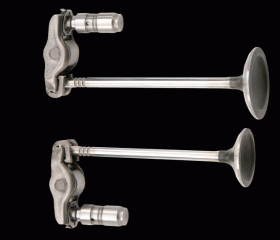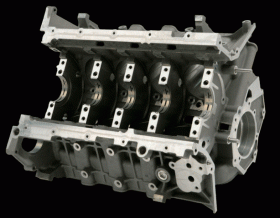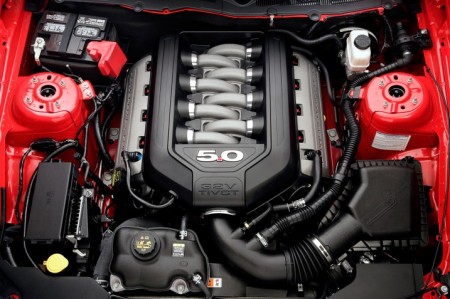 In what is likely to have been the best promoted secret in recent Ford history, a thoroughly modern V8 engine debuted recently at the North American International Auto Show. Through the past 2 years, politicians, Ford and union executives alike have been talking about the return of the 5.0-liter engine as though it was the resurrection itself. Yes, the memories are fond, but the details – cast in a modern light – are remarkably different.
In what is likely to have been the best promoted secret in recent Ford history, a thoroughly modern V8 engine debuted recently at the North American International Auto Show. Through the past 2 years, politicians, Ford and union executives alike have been talking about the return of the 5.0-liter engine as though it was the resurrection itself. Yes, the memories are fond, but the details – cast in a modern light – are remarkably different.
Nestled between the strut towers of a 2011 Mustang GT in Detroit’s Cobo Hall, the new V8 appears at first glance to be little more than a few pieces of snap together plastic bearing a traditional 5.0 emblem at the front. Truly, the beauty here is more than skin deep. Beneath the composite plastic intake manifold and cam covers, the engine – code named Coyote – is a clean sheet design, sharing its heritage but little else with Ford’s past modular motors. In fact, this aluminum block, double overhead cam design shares nothing with the Mustang’s previous 4.6-liter, V8 engine, save a few common fasteners.
In production form, the modern 5.0-liter will deliver 412 horsepower and 390 ft.-lb. of torque. At the same time, fuel economy is expected to be better than the previous model. Though we may get a little used to hearing such numbers these days, the last 4.6-liter modular motor to come close was the supercharged, Terminator engine in the 2003-04 SVT Cobra. So, where’s the blower?
Remember that clean sheet we mentioned earlier? That’s where the development team started and took the time to focus on a number of engine fundamentals. Among these were volumetric efficiency, thermal efficiency and parasitic loss.
When you are dealing with a new design, it should be clear that the best way to make power is to stop losing it. One of the fastest ways to do this is by increasing volumetric efficiency – that’s the amount of fresh air that is drawn into the cylinder during the intake stroke. An average number here – about 73% – means that your 5.0-liter engine is putting power out like a 3650 cc mill.
Particular attention was paid to the cylinder heads and exhaust manifolds. The valve train design was optimized to allow maximum flow into the cylinders, while cooling and strength could not be compromised. Part of the power this engine puts out comes from running an 11:1 compression ratio, which places additional demands on the motor’s structural components. Larger bolts keep the cylinder heads in place and several measures are used in the aluminum block to keep reliability at world class level. Among these are a 4-bolt main bearing setup, wider bearing lands and additional ribbing, both internal and external, for extra strength.
Beyond these rather conventional technologies, the 5.0-liter V8 debuts its share of starship magic, in the form of Twin Independent Variable Camshaft Timing. Separate control of the intake and exhaust cams provides maximum fuel economy at part-throttle, while delivering optimized power in full-throttle situations. An added benefit is improved drivability and responsiveness across the torque curve. Variable cam timing first saw the light of day in the 3-valve version of the 4.6 Mustang engine for the 2005 model year.
These engines used the output from a high pressure oil pump as the means to move cam timing around. The current motor uses a combination of lower oil pressure and camshaft torque to actuate the needed pieces. Camshaft torque energy provides faster throttle response and maximizes use of existing energy, to improve fuel economy through reduction of parasitic losses. With similar objectives, the new engine’s oil pan gasket incorporates an integral windage tray. That gasket seals a baffled, deep sump oil pan that can help make track days significantly less worrisome to the sportsman, or improve the normal use oil change interval to 10,000 miles.
Todd Brewer worked as cylinder head tec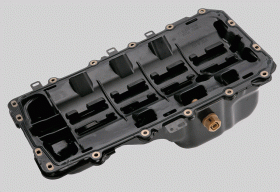 hnical expert for the Coyote program. “We are all very proud of the 5.0-liter V-8,” he said. “It’s the opportunity for the team to deliver a world-class engine in terms of specific output – more than 80 horsepower per liter – and improved fuel economy, while employing implementation-ready approaches and technologies. It’s a high-volume, affordable engine that can compete with much more expensive and exotic engines.”
hnical expert for the Coyote program. “We are all very proud of the 5.0-liter V-8,” he said. “It’s the opportunity for the team to deliver a world-class engine in terms of specific output – more than 80 horsepower per liter – and improved fuel economy, while employing implementation-ready approaches and technologies. It’s a high-volume, affordable engine that can compete with much more expensive and exotic engines.”
Compared to the LS Family
Not all of those engines come from foreign competitors, though. On the roads and boulevards this spring, one of the most anticipated match-ups will be that of the new 5.0-liter Mustang and the contemporary Camaro SS. In its current form, the manual transmission version of the SS arrives with the 6.2-liter LS3 engine, first introduced in 2008 for the Corvette. In the 2010 Camaro SS, the LS3 puts out 422 HP and 408 lb.-ft. of torque.
Evolved from the LS2, the aluminum small block gained almost 2 mm bore in addition to high flow fuel injectors from the LS7. Like the Mustang design, intake flow efficiency was optimized by straightening out and optimizing the flow path from the intake manifold into the LS7-derived cylinder heads. A high flow induction system was borrowed from 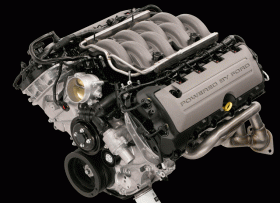 the Z06 as well. With a nod to more conventional technologies, the SS uses nodular cast iron exhaust manifolds, though matched to the reshaped exhaust ports on the engine. Cast iron does offer some advantage in managing underhood noise.
the Z06 as well. With a nod to more conventional technologies, the SS uses nodular cast iron exhaust manifolds, though matched to the reshaped exhaust ports on the engine. Cast iron does offer some advantage in managing underhood noise.
While both the LS3 and the modern 5.0-liter V8 manage to deliver comparable numbers, they do so in different ways. Ceding 1.2 liters of displacement to the LS3, Ford relies on an advanced DOHC configuration and internal efficiencies that could only be gained from a clean sheet redesign. Materials technologies are similar between the two, from aluminum block and heads to composite intake manifolds. Other performance-driven additions are shared between the two, from roller rocker arms, to coil-on-plug ignition and returnless, multi-port fuel injection. Beyond the issues of camshafts and displacement, these two engines could be seen as more alike than they are different.
So, who’s going to take the brass ring? A manual transmission Camaro SS weighs in at 3860 lbs. (1755 kg), while the 6-speed 2011 Mustang GT is tagged at 3,720 lbs. (1691 kg). Do the power to weight math and you’ll find that its way too close to call. Assuming dead stock cars, driver skill, and perhaps weight, is going to be the determining factor.
God bless the pony car wars!


